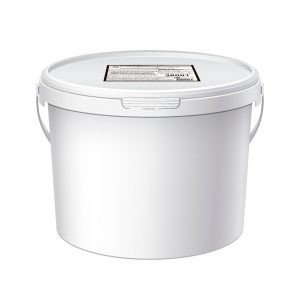
Optimizing baked and confectionery goods production process has always been a key aspect of food industry. Right now, this aspect takes center stage. In this article, we talk about optimizing production processes, reducing production cost, improving product quality and strengthening its competitive advantages using SOLPRO emulsifier pastes.
SOLPRO emulsifier pastes include a carefully selected emulsifier composition based on natural fats that form a stable emulsion fast. Introducing a paste into the dough makes for uniform distribution of air fraction, fat and other recipe components. Furthermore, if emulsifier action is normally based on their ability to disperse fatty components in water, in SOLPRO pastes this ability is secondary. The more important property is its surface action, including dough aeration and starch components production.
Let’s talk further about SOLPRO paste components and their functions.
Emulsifiers The paste includes fatty acid mono- and diglycerides (Е471), polyglycerol and fatty acids esters (Е475). The former one is for softening. The supplement attaches itself to wheat starch amylose fraction at high temperatures typical for baking. That slows down starch reversion during cooling and subsequent storage.
Mono- and diglycerides in the paste have hydrated gel form. The hydrated are oil-in-water emulsions produced by mixing molten emulsifier with hot water and a small quantity of stabilizer and subsequent cooling and mixing in a controlled environment until the emulsion is stable. If done correctly, the emulsion will preserve regular crystal structure for a long time. Emulsifier content in hydrates is 18–40%.
Like other emulsifiers, polyglycerol and fatty acids esters (PGEs) are both hydrophobic and hydrophilic, so they can reduce interfacial tension between different phases. PGEs in water form a highly stable alpha-gel system which is surface active and stabilizes foam if the mass temperature is below the emulsifier melting temperature. The structure of PGE-generated alpha-gel is more thermodynamically stable compared to monoglycerides. That’s why using mono- and diglycerides together with PGEs improves the churned mass aeration and stability.
Moisture retention components Emulsifier pastes contain glycerol and propylene glycol that keep water from migrating, thus extending the product shelf life. They also slow down starch reversion in baked goods and sucrose crystallization in fondant candies and fruit fillings.
Another way in which moisture retention components impact the crystallization process is that they make the ingredients mixture more complex, thus slowing down crystallization rate.
The role emulsifiers play in ready-made baked cake components is manifold. It includes improved aeration, emulsification and crumb softness.
Using SOLPRO emulsifier pastes reduces surface tension at the water-air line, improving sponge cake air intake. If the dough has a lot of fine air pores, the semi-finished product will be more voluminous and porous. Crumb texture in ready-made baked components depends on moisture retention, fat action and starch compound formation.
Emulsifier pastes are particularly effective for recipes utilizing liquid vegetable oils. That is because when churned, such oils capture air, but can’t retain it because of lack of solid triglycerides. Emulsifiers solve this issue, producing stable dough rich in air bubbles.

Emulsifiers in the paste form starch compounds thus making the crumb in baked goods softer. That is particularly important for products with high moisture content (>13%) and high water activity (аW > 0.6).
Although their impact mechanism is subject to dispute, we have reasons to believe the bulk of their effect is related to amylose, a linear starch fraction. The opinion is that baked goods getting stale is a result of amylose crystallization. Amylose is leached out of starch kernels during dough production. Crumb softeners reduce amylose release during baking, thus reducing the content of free amylose that helps produce hardened gel. Emulsifiers “soften” the original crumb.
Despite there being no strict dosage rules concerning pastes dosage in bread and rich dough products, you may consider following these rules:
– to materially improve shelf life of standard white bread, hydrate content at 1% of the flour weight would be enough;
– for rich dough products, add 50% fat (of the recipe value) and 10-25% hydrate (of the recipe fat value).
Which products are SOLPRO pastes best suited for?
Maximum effect is achieved when using pastes in the following products:
Let’s take a closer look at the two main advantages of these food supplements: reduced production cost and uniform quality of each finished piece.
Is achieved through synergies in several areas at once:
The raw materials used in baked and confectionery products have seasonal variations impacting the finished product. That is true for new harvest flour and eggs. Using SOLPRO emulsifier pastes solved those process issues and guarantees stable high quality of finished product.
There are also the following paste advantages:
All paste components conform to Technical Regulations of the Customs Union CU TR 029/2012 Safety requirements for food additives, flavouring agents and processing supplements. Emulsifiers included in these food additives are safe for human consumption. They are absorbed by the human body exactly like other fats are and broken down by lipase, an enzyme produced by the body.
See the table below for main sensory parameters.
| Parameter | Value |
|---|---|
| Smell | Weak, characteristic of emulsifier paste |
| Color | From colorless to pearl white |
| Texture at 20 °С | Homogeneous, paste (gel) |
| Mass fraction of moisture and volatile matter, % max 38001 38002 | 68 58 |
| рН | 8,5–9,5 |
SOLPRO pastes are sold in plastic 10 l buckets. Storage life 9 months. Pastes are to be stored in a cool place and handled with clean tools.

For more details about the SOLPRO brand, visit our new product catalogue at solpro.ru. We also recommend subscribing to SOLPRO_EXPERT VKontakte group and out Telegram channel.
SOLPRO technologists are open for dialogue and always happy to answer any questions you might have or help you develop product concepts. Call 8 (999) 555-77-68 to get advice on which product to choose.
Tamara Dukhu,
PhD, Engineering
Confectionery Development Manager
RUSAGRO,Oil&Fats Business
Olga Gaidachenko.
Sale Support Technologist
RUSAGRO,Oil&Fats Business